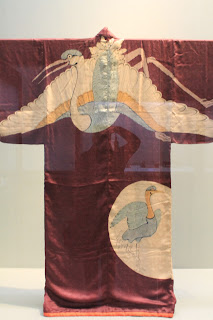Noch eine Zeitreise, diesmal durch die Kunstgeschichte Japans.
Das Museum befindet sich am Nordende des Ueno Park und der Zugang wird gerade erneuert, jedenfalls waren fleißige Bauarbeiter mit Bagger und Planierraupe zu Gange. Die Umleitung war gut ausgeschildert und wer lesen kann, ist klar im Vorteil, ich kann keine Kanji lesen, darum war ich hier im Nachteil und habe statt der Umleitung einen Umweg gewählt. Dieser führte mich vorbei an einem Gebiet, das als Shelter for Homeless (Schutz für Obdachlose) ausgewiesen ist. Es gab ein großes Zelt, eine Wasserleitung, die Möglichkeit, Kleidung zu waschen, und gerade standen viele Leute diszipliniert an, um Lebensmittel zu erhalten.
Und dann kam auch bald der Eingang zum Museum in Sicht und hier kann man sich, wenn keine Sonderwünsche bestehen, eine Eintrittskarte am Automaten ziehen, praktisch.
Im Museum werde ich von einer netten älteren Dame im Kimono gefragt, ob ich Deutsche bin (hat mich im Kaisergarten auch jemand gefragt, sieht man mir das an, bin erschüttert), ich bejahe und sie reicht mir einen deutschsprachigen Museumsplan und sagt dann "Guten Tag". Zauberhaft.
Nun gehts los, was bin ich heute wieder unkonventionell, ich fange dann mal von rückwärts an.
Aber hier vorwärts, die ältesten Exponate sind auf ca 2000 bis 3000 v.Ch. datiert, Töpferwaren aus der Jomon Zeit, aus der Yayoi Zeit (1.-3. Jh.), Statuen aus der Zeit des Aufsteigen des Buddhismus in Japan, Schriftrollen, Tuschezeichnungen, Rüstungen von 16. -19.Jh., Lackarbeiten, Metallarbeiten, Keramik, No und Kabuki, Ukiyo-e, Spiele, Kimonos und Schmuck. Die jüngsten Exponate stammen aus den 30er Jahren des letzten Jahrhunderts.
Just another journey back in time, this time through the history of japanese art.
The Museum is at the north end of Ueno Park and the path to go there is just under reconstruction, anyhow very hardworking men with excator and bulldozer were afoot. The detour was well signposted, and one who can read is definitly in advance, I can´t read Kanji there for I´m in disadvance, and instead of the detour I took the roundabout route, passing a shelter for homeless area, with a big tent, a waterpipe, a opportunity to wash clothes and a crowd of men waitng patiently in line for getting food.
And finally I see the entrance of the museum, and if one don´t want something extraordinary than is there an automat for the tickets, handy.
Inside I was welcomed by a nice elderly lady wearing a Kimono and ask me if I´m german (have been asked the same question the other day, do I look like that, I´m shocked), I do affirm and she gave me a museum guide in german and than said "Guten Tag". Enchanting.
And now let´s start and I´m again that bohemian, I do start at the end.
But here let´s beginn with the beginning, the eldest exhibit is dated from 2000-3000 BC, a pottery from the Jomon period, and even stuff from the Yayoi time (1.-3. century), statues from the time of the rising of the Buddhism in Japan, scrolls, ink paintings, armours from the 16.-19. century, lacquework, metalwork, pottery, No and Kabuki, Ukiyo-e, games, Kimono and juwelary. The youngest exhibit is from the 30s of the last century.






























































Keine Kommentare:
Kommentar veröffentlichen